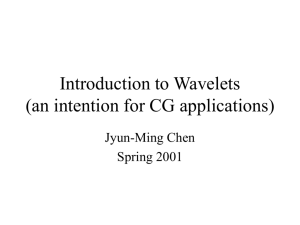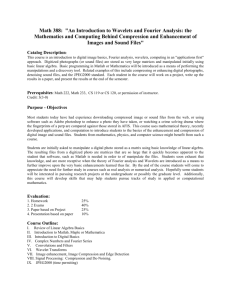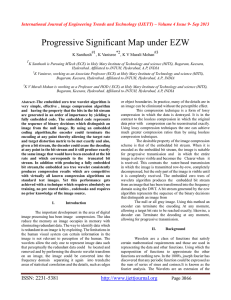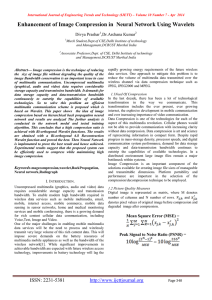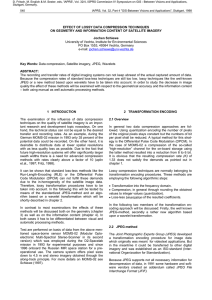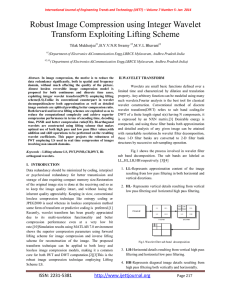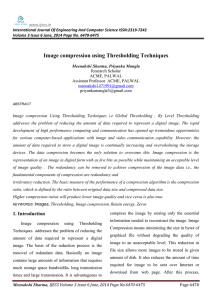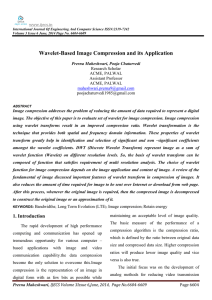Wavelets can be used to incorporate real applications into an... namely Linear Algebra. The project described here is based...
advertisement
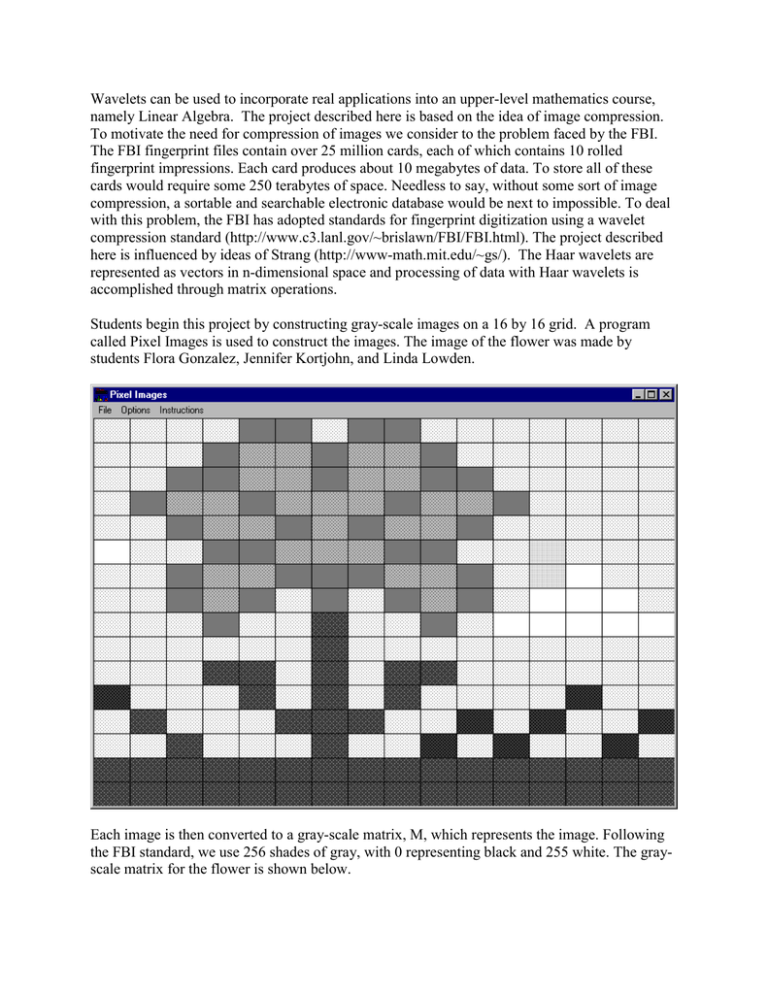
Wavelets can be used to incorporate real applications into an upper-level mathematics course, namely Linear Algebra. The project described here is based on the idea of image compression. To motivate the need for compression of images we consider to the problem faced by the FBI. The FBI fingerprint files contain over 25 million cards, each of which contains 10 rolled fingerprint impressions. Each card produces about 10 megabytes of data. To store all of these cards would require some 250 terabytes of space. Needless to say, without some sort of image compression, a sortable and searchable electronic database would be next to impossible. To deal with this problem, the FBI has adopted standards for fingerprint digitization using a wavelet compression standard (http://www.c3.lanl.gov/~brislawn/FBI/FBI.html). The project described here is influenced by ideas of Strang (http://www-math.mit.edu/~gs/). The Haar wavelets are represented as vectors in n-dimensional space and processing of data with Haar wavelets is accomplished through matrix operations. Students begin this project by constructing gray-scale images on a 16 by 16 grid. A program called Pixel Images is used to construct the images. The image of the flower was made by students Flora Gonzalez, Jennifer Kortjohn, and Linda Lowden. Each image is then converted to a gray-scale matrix, M, which represents the image. Following the FBI standard, we use 256 shades of gray, with 0 representing black and 255 white. The grayscale matrix for the flower is shown below. 240 240 240 240 240 255 240 240 240 240 240 50 240 240 75 75 240 240 240 130 130 240 130 130 240 240 240 240 240 240 240 240 130 175 175 130 175 175 130 240 240 240 240 240 240 130 130 175 175 130 175 175 130 130 240 240 240 240 130 175 175 130 175 175 175 130 175 175 130 240 240 240 240 130 175 175 130 175 130 175 175 130 240 240 240 240 240 240 130 130 175 175 175 130 130 240 240 225 240 240 240 130 175 175 130 130 130 175 175 130 240 225 255 240 240 130 175 130 240 130 240 130 175 130 240 255 255 255 240 240 130 240 240 75 240 240 130 240 255 255 255 255 240 240 240 240 240 75 240 240 240 240 240 240 240 240 240 240 75 75 240 75 240 75 75 240 240 240 240 240 240 240 240 75 240 75 240 75 240 240 240 240 50 240 75 240 240 240 75 75 75 240 240 50 240 50 240 240 240 75 240 240 240 75 240 240 50 240 50 240 240 50 75 75 75 75 75 75 75 75 75 75 75 75 75 75 75 75 75 75 75 75 75 75 75 75 75 75 75 75 240 240 240 240 240 240 240 240 255 240 240 240 50 240 75 75 Throughout the course, we discuss how wavelets are used to process this kind of data. The ideas that are needed to understand the process are matrix multiplication, how to solve systems of linear equations, matrix inverses, linear combinations, linear dependence and independence, bases, and how to identify piecewise constant functions with vectors in n-space. Through these discussions, students learn how to process their gray-scale matrices using matrices. Specifically, they construct the 16 by 16 wavelet matrix A: 1 1 1 1 1 1 1 1 1 1 1 1 1 1 1 1 1 1 0 1 0 0 0 1 0 0 0 0 0 0 1 1 0 1 0 0 0 -1 0 0 0 0 0 0 1 1 0 -1 0 0 0 0 1 0 0 0 0 0 1 1 0 -1 0 0 0 0 -1 0 0 0 0 0 1 -1 0 0 1 0 0 0 0 1 0 0 0 0 1 -1 0 0 1 0 0 0 0 -1 0 0 0 0 1 -1 0 0 -1 0 0 0 0 0 1 0 0 0 1 -1 0 0 -1 0 0 0 0 0 -1 0 0 0 -1 0 1 0 0 1 0 0 0 0 0 1 0 0 -1 0 1 0 0 1 0 0 0 0 0 -1 0 0 -1 0 1 0 0 -1 0 0 0 0 0 0 1 0 -1 0 1 0 0 -1 0 0 0 0 0 0 -1 0 -1 0 -1 0 0 0 1 0 0 0 0 0 0 1 -1 0 -1 0 0 0 1 0 0 0 0 0 0 -1 -1 0 -1 0 0 0 -1 0 0 0 0 0 0 0 -1 0 -1 0 0 0 -1 0 0 0 0 0 0 0 0 0 0 0 0 0 0 0 0 0 0 0 0 0 1 -1 The wavelet coefficients for their images are found by solving the matrix equation AX = M. Since A is invertible, this equation is easily solved with Maple. Once the wavelet coefficients are found, do hard thresholding to achieve further compression. They then de-process the data to see what the reconstructed image will look like. With a threshold level of 6, the reconstructed flower image looks like We think this project is an excellent example of how the ideas students meet in linear algebra are used in the "real world" and our students have responded positively to the experience. For more information contact us at : Ed Aboufadel (aboufade@gvsu.edu) Steve Schlicker (schlicks@gvsu.edu) Department of Mathematics and Statistics Grand Valley State University Allendale, MI 49401
